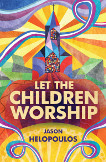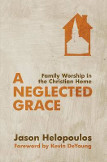
Noah's Ark and the Cross of Christ
Is Noah’s ark a type of the cross? Is it a prophetic picture of what Christ did on Calvary? People often scoff at the idea, and perhaps even mock preachers who make typological connections by highlighting that just as the ark was made of wood, so the cross was made of wood. The critics are right to disdain such incidental and coincidental resemblances as evidence of typology. (e.g. see John Calvin's criticism of Augustine's fanciful interpretation in his comments on Genesis 6:14). However, they are wrong to use such tenuous connections to trash any possibility of the ark being a type of Christ. I believe that the ark is a type, a prophetic picture, of Christ’s person and work, but the resemblances are at a much more fundamental level than the material that both the ark and the cross were made of.
Biblical Presuppositions
Let’s start with a couple of foundational presuppositions:
1. The Old Testament is a revelation of God. Everything in it tells us what God is like and what God does.
2. God’s Genesis 3:15 promise to save sinners through a future deliverer created a forward-looking, a futuristic momentum to all subsequent revelation.
Putting both of these together, we can say that God revealed Himself and His future salvation to Old Testament believers through Old Testament characters, events, objects, etc.
That’s why I define typology as: A real person, place, object, or event that God ordained to act as a predictive pattern or resemblance of Jesus’ person and work.
With that in place, let’s now work through some of the questions I list for types in Jesus on Every Page:
1. Is the type real?
Unlike an allegory which may be fictional, a type is always a real someone or something. In this case, we are looking at the ark and the flood, a real historical object and event.
2. Is the type explicit or implied?
Does the Bible anywhere explicitly identify the ark as a type? Although there are more types in the Bible than those explicitly identified as such, if it’s explicitly identified, then that’s a huge advantage. What about Peter’s words?
The Divine longsuffering waited in the days of Noah, while the ark was being prepared, in which a few, that is, eight souls, were saved through water. There is also an antitype which now saves us—baptism (not the removal of the filth of the flesh, but the answer of a good conscience toward God), through the resurrection of Jesus Christ, who has gone into heaven and is at the right hand of God, angels and authorities and powers having been made subject to Him (1 Peter 3:20-22)
Although these are some of the most difficult verses to understand in the whole Bible, we can say that Peter explicitly identifies the ark in the flood as a type of the salvation that Christ provides, with the antitype (the fulfillment) being what baptism signifies.
3. What was the type intended to teach the original audience?
Here we have to try really hard to not fast forward to the fulfillment of the type, and then read similarities back on to the type. We have to try to view the type through the eyes of Old Testament believers who did not have the benefit of New Testament fulfillment.
Noah and the Old Testament believers who read this story should have learned:
- God is holy, hates sin, and is determined to punish it with the full force of his justice.
- God provides sinners with a divinely approved means of escape.
- God patiently calls sinners to safety in His merciful provision.
- God protects and saves those who put their faith in Him and use His refuge.
- God’s wrath purges the world of sin and unrepentant sinners but will not touch those who are in His appointed place of refuge.
4. How did an Old Testament believer use or relate to the type by faith?
Genesis 3:15 told them who would save them from their deserved punishment for sin – the Seed of the woman. Noah’s ark told them a bit more of the how – by putting their faith in God’s Word and trusting in His appointed refuge, they would escape His just anger.
5. What are the essential resemblances?
This is the heart of typology, the essential resemblances, not the incidental or external resemblances (such as the wood).
- Just as the flood revealed that God is holy, hates sin, and is determined to punish it with the full force of his justice, so the first and second coming of Christ reveals the same.
- Just as God provides sinners with a divinely approved means of escape, so in Christ God provides sinners with a divinely approved means of escape.
- Just as God patiently calls sinners to safety in His merciful provision, so He calls us to believe in Him and trust in His refuge of mercy--Jesus Christ.
- Just as God protected and saved those who put their faith in Him and used His refuge, so God protects and saves all who put their trust in Jesus Christ as a refuge from God’s anger.
- Just as the flood purged the earth of sin, unrepentant sinners and saved refuge-takers for a new and better beginning, so baptism signifies (though it does not, of itself, secure) God’s gracious work of cleansing the soul from corruption and a new beginning.
The fulfillment presents the same truths enlarged, clarified, and heightened. These truths commenced fulfillment at the first coming of Christ, continue being fulfilled as sinners are saved throughout church history, and will achieve consummate fulfillment at the end of the world.
_______________________________________
Related Resources
James Muirhead A Dissertation on the Foederal Transactions Between God and His Church(Kelso: Printed by James Palmer, 1782) pp. 63-86 (see esp. pp. 76-79)
Thomas Manton The Complete Works of Thomas Manton (London: James Nisbet & Co., 873) vol. 14 pp. 175-177
Jonathan Edwards A History of the Work of Redemption (Worcester: Isaac Stutevant, 1808) pp. 47-48
Jonathan Edwards The Works of of Jonathan Edwards (London: William Ball, 1839) Notes on the Bible #297 p. 695
Henry Law Christ is All: The Gospel in Genesis(London: J. Whereat, 1855) pp. 89-110; see esp. pp. 95 ff.
Matthew Henry Commentary on the Whole Bible(see comments on 6:22 and 7:1)
Nick Batzig "Four Points About the Noahic Covenant and Redemptive History"



















 © Alliance of Confessing Evangelicals
© Alliance of Confessing Evangelicals


